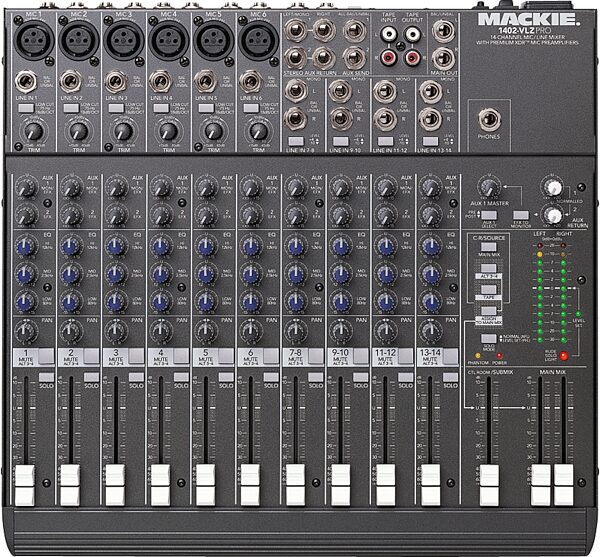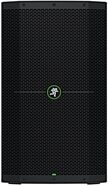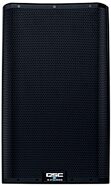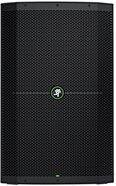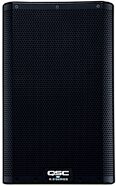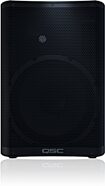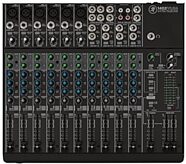
Mackie 1402VLZ4 14-Channel Mixer
Get the inputs you need with the tough Mackie 1402VLZ4 mixer: 6 Onyx microphone preamps, 4 stereo channels, and 2 auxes, all in a super-compact footprint.
$359.99
- 8 x$45.00
- No Credit Check6 x$60.00
- No Credit Check4 x$90.00
Mackie 1402-VLZ Pro 14-Channel Mixer
No longer available at zZounds
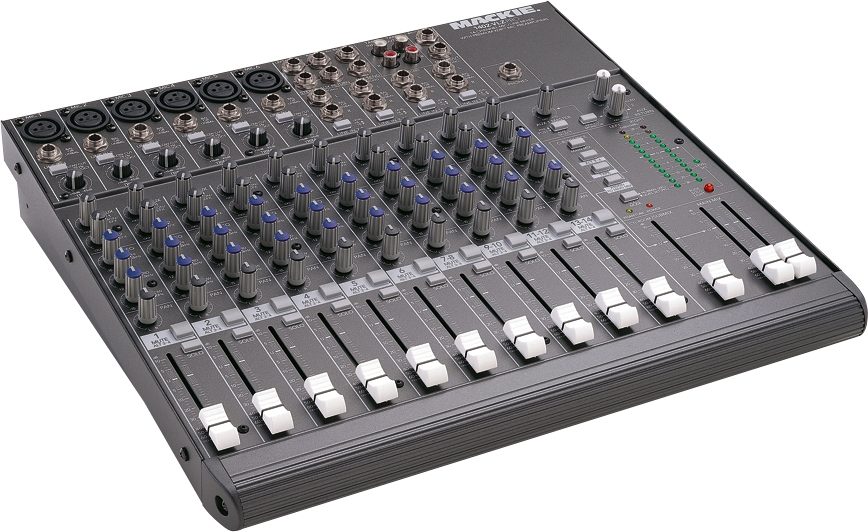


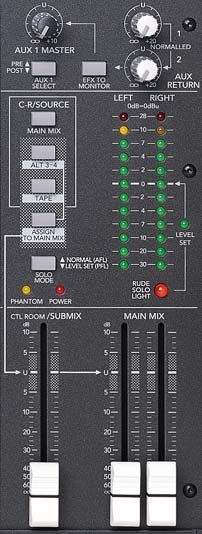



14 line inputs (6 mono, 4 stereo pairs).
Overview
This 14x2x1 mixer includes Mackie's new XDR (eXtended Dynamic Range) mic preamps with sound quality matching or exceeding the performance of $500 to $2000-per-channel esoteric preamps.
Features
Ultra-low noise, highest headroom in its class
6 new precision-engineered XDR Extended Dynamic Range premium studio-grade mic preamps with:
-Ultra-wide 0-60dB gain range
-130dB dynamic range for 24-bit, 192kHz sampling rate inputs
-+22dBu line input handling
-Distortion under 0.0007% (20Hz-20kHz)
Advanced DC-pulse transformer RF rejection
60mm long-wearing log-taper faders
14 line inputs (6 mono, 4 stereo pairs)
Separate RCA-type tape/CD inputs and tape outputs (unbalanced)
2 aux sends with 15dB of gain above Unity
Aux 1 pre/post
Constant-loudness pan pots
Switchable AFL/PFL Solo
2 stereo aux returns with EFX to Monitor switch
Aux 1 master with Monitor/Post assign switch
3-band active EQ (80Hz, 2.5kHz, 12kHz)
18dB/oct. 75Hz Lo Cut filter eliminates stage rumble, wind noise, P-pops, and low frequency recording studio room resonances
Extra ALT 3-4 stereo bus for submixes, separate recording, monitor, and "mix minus" feeds
Control Room/Phones multi-input source matrix
Phantom power for premium condenser mics
Rugged steel chassis, sealed rotary controls
Built-in power supply - no wall wart!
About XDR: eXtended Dynamic Range Mic Preamps
No matter how much you spend on a microphone, its ultimate performance depends on how it interacts with the preamp it's plugged into. Many… read more high-end mic preamps can effortlessly amplify the slightest sonic nuance, creating an aural panorama that's breathtakingly realistic, excitingly vivid, and truly 3-dimensional in scope. For years they've provided fidelity that just hasn't been possible with the "stock" mic preamps built into mixing consoles. Until now.
To develop the new XDR(tm) (eXtended Dynamic Range) mic preamp, Mackie's engineering team started with blank paper, concerned only with matching or exceeding the performance of $500 to $2000-per-channel esoteric preamps. They went through hundreds of iterations and revs and spent countless hours subjectively listening (and arguing). They started all over again several times. They scoured the world for rare parts. Then they spent more time critically listening and evaluating the design with every high-end microphone you can think of. Then they brought in veteran recording and live sound engineers for more exhaustive listening tests.
What they ultimately ended up with is not just an awesome sounding design. XDR is also a) highly resistant to damage caused by "hot patching" (caused by routing a phantom powered mic through a patch bay); b) remarkably independent of cable-induced impedance variations; and c) able to reject extremely high RF levels without compromising high frequency response.
Because a mic preamp must amplify faint one millivolt input signals up to a thousand-fold (60dB), its rectification components can also pick up radio frequency interference (RFI) from AM and FM stations, cell phones, and pager transmitters - even microwave ovens - and amplify them to audible levels.
Mackie assaulted RFI on 3 fronts. First, they incorporate bifilar wound DC pulse transformers with high permeability cores that reject RFI but don't attenuate the sound at 15kHz and above. Second, they use carefully matched, high-precision components for critical areas of the XDR preamplifier. Third, they direct-coupled the circuit from input to output and used pole-zero cancellation constant current biasing (which also avoids increased intermodulation distortion at high common mode signal levels).
Bottom line for the non-technical: you can use the new XDR mic preamps at the end of extremely-long cheap mic cables in an RFI-saturated urban environment while talking on your cell phone... without hearing a trace of RFI.
If a mic preamp isn't designed right, it will actually sound different depending on the impedance of the microphone and the cable load! XDR's Controlled Interface Input Impedance system accepts an enormous range of impedances without compromising frequency response.
0.0007% Total Harmonic Distortion. The lowest ever in any compact mixer.
Flat response. Not only are XDR mic preamps flat within a tenth of a dB across the bandwidth of any known microphone, but are also only 3dB down at an astonishing 192kHz!
Super-low intermodulation distortion at very high operating levels thanks to instrumentation-style balanced differential architecture, linear biasing, and use of DC-coupled pole-zero-cancellation constant current that frees the mic preamp from power supply fluctuations.
Think of the 1402 as an ultra-premium, esoteric mic preamp... that just happen to have really excellent compact mixers attached. read less
Features
Ultra-low noise, highest headroom in its class
6 new precision-engineered XDR Extended Dynamic Range premium studio-grade mic preamps with:
-Ultra-wide 0-60dB gain range
-130dB dynamic range for 24-bit, 192kHz sampling rate inputs
-+22dBu line input handling
-Distortion under 0.0007% (20Hz-20kHz)
Advanced DC-pulse transformer RF rejection
60mm long-wearing log-taper faders
14 line inputs (6 mono, 4 stereo pairs)
Separate RCA-type tape/CD inputs and tape outputs (unbalanced)
2 aux sends with 15dB of gain above Unity
Aux 1 pre/post
Constant-loudness pan pots
Switchable AFL/PFL Solo
2 stereo aux returns with EFX to Monitor switch
Aux 1 master with Monitor/Post assign switch
3-band active EQ (80Hz, 2.5kHz, 12kHz)
18dB/oct. 75Hz Lo Cut filter eliminates stage rumble, wind noise, P-pops, and low frequency recording studio room resonances
Extra ALT 3-4 stereo bus for submixes, separate recording, monitor, and "mix minus" feeds
Control Room/Phones multi-input source matrix
Phantom power for premium condenser mics
Rugged steel chassis, sealed rotary controls
Built-in power supply - no wall wart!
About XDR: eXtended Dynamic Range Mic Preamps
No matter how much you spend on a microphone, its ultimate performance depends on how it interacts with the preamp it's plugged into. Many… read more high-end mic preamps can effortlessly amplify the slightest sonic nuance, creating an aural panorama that's breathtakingly realistic, excitingly vivid, and truly 3-dimensional in scope. For years they've provided fidelity that just hasn't been possible with the "stock" mic preamps built into mixing consoles. Until now.
To develop the new XDR(tm) (eXtended Dynamic Range) mic preamp, Mackie's engineering team started with blank paper, concerned only with matching or exceeding the performance of $500 to $2000-per-channel esoteric preamps. They went through hundreds of iterations and revs and spent countless hours subjectively listening (and arguing). They started all over again several times. They scoured the world for rare parts. Then they spent more time critically listening and evaluating the design with every high-end microphone you can think of. Then they brought in veteran recording and live sound engineers for more exhaustive listening tests.
What they ultimately ended up with is not just an awesome sounding design. XDR is also a) highly resistant to damage caused by "hot patching" (caused by routing a phantom powered mic through a patch bay); b) remarkably independent of cable-induced impedance variations; and c) able to reject extremely high RF levels without compromising high frequency response.
Because a mic preamp must amplify faint one millivolt input signals up to a thousand-fold (60dB), its rectification components can also pick up radio frequency interference (RFI) from AM and FM stations, cell phones, and pager transmitters - even microwave ovens - and amplify them to audible levels.
Mackie assaulted RFI on 3 fronts. First, they incorporate bifilar wound DC pulse transformers with high permeability cores that reject RFI but don't attenuate the sound at 15kHz and above. Second, they use carefully matched, high-precision components for critical areas of the XDR preamplifier. Third, they direct-coupled the circuit from input to output and used pole-zero cancellation constant current biasing (which also avoids increased intermodulation distortion at high common mode signal levels).
Bottom line for the non-technical: you can use the new XDR mic preamps at the end of extremely-long cheap mic cables in an RFI-saturated urban environment while talking on your cell phone... without hearing a trace of RFI.
If a mic preamp isn't designed right, it will actually sound different depending on the impedance of the microphone and the cable load! XDR's Controlled Interface Input Impedance system accepts an enormous range of impedances without compromising frequency response.
0.0007% Total Harmonic Distortion. The lowest ever in any compact mixer.
Flat response. Not only are XDR mic preamps flat within a tenth of a dB across the bandwidth of any known microphone, but are also only 3dB down at an astonishing 192kHz!
Super-low intermodulation distortion at very high operating levels thanks to instrumentation-style balanced differential architecture, linear biasing, and use of DC-coupled pole-zero-cancellation constant current that frees the mic preamp from power supply fluctuations.
Think of the 1402 as an ultra-premium, esoteric mic preamp... that just happen to have really excellent compact mixers attached. read less
Specs
Main Mix Noise
20Hz-20kHz bandwidth, 1/4 in. Main out, channels 1-6 Trim @ unity gain, channel EQs flat, all channels assigned to Main Mix, channels 1 and 3 Pan left, 2 and 4 Pan right
Main Mix fader down, channel faders down: -100dBu
Main Mix fader unity, channel faders down: (90dB Signal-to-Noise Ratio, ref +4dBu) -86.5dBu
Main Mix fader @ unity, channel faders @ unity: -84.5dBu
Total Harmonic Distortion (THD)
1kHz @ +14dBu: 20Hz-20kHz
Mic in to Main out: 0.0007%
Attenuation (Crosstalk)
1kHz relative to 0dBu, 20Hz-20kHz bandwidth, Line in, 1/4 in. Main Out, Trim @ unity
Main fader down: -85dBu
Channel Alt/Mute switch engaged: -84dBu
Channel fader down: -83dBu
Frequency Response
Mic input to any output
20Hz to 60kHz: +0dB/-1dB
10Hz to 100kHz: +0dB/-3dB
Equivalent Input Noise (EIN)
Mic in to insert Send out, max gain
150-ohm termination: -129.5dBm unweighted
Common Mode Rejection (CMR)
Mic in to insert Send out, max gain
1kHz: better than 90dB
Maximum Levels
Mic In: +22dBu
Tape In: +16dBu
All other inputs: +22dBu
Main Mix XLR outputs: +28dBu
All other outputs: +22dBu
Impedances
Mic In: 1.3 kilohms
Channel Insert return: 2.5 kilohms
All other inputs: 10 kilohms or greater
Tape out: 1.1 kilohms
All other outputs: 120 ohms
EQ
High Shelving: �15db @ 12kHz
Mid Peaking: �12dB @ 2.5kHz
Low Shelving: �15db @ 80Hz
Power Consumption
120VA.C., 50/60Hz, 25 watts
Fuse Ratings
120V: 0.5A Slo Blo, 5 x 20mm
220-240V: 0.25A Slo Blo, 5 x 20mm
Weight
9.5 lbs. (4.5 kg)
20Hz-20kHz bandwidth, 1/4 in. Main out, channels 1-6 Trim @ unity gain, channel EQs flat, all channels assigned to Main Mix, channels 1 and 3 Pan left, 2 and 4 Pan right
Main Mix fader down, channel faders down: -100dBu
Main Mix fader unity, channel faders down: (90dB Signal-to-Noise Ratio, ref +4dBu) -86.5dBu
Main Mix fader @ unity, channel faders @ unity: -84.5dBu
Total Harmonic Distortion (THD)
1kHz @ +14dBu: 20Hz-20kHz
Mic in to Main out: 0.0007%
Attenuation (Crosstalk)
1kHz relative to 0dBu, 20Hz-20kHz bandwidth, Line in, 1/4 in. Main Out, Trim @ unity
Main fader down: -85dBu
Channel Alt/Mute switch engaged: -84dBu
Channel fader down: -83dBu
Frequency Response
Mic input to any output
20Hz to 60kHz: +0dB/-1dB
10Hz to 100kHz: +0dB/-3dB
Equivalent Input Noise (EIN)
Mic in to insert Send out, max gain
150-ohm termination: -129.5dBm unweighted
Common Mode Rejection (CMR)
Mic in to insert Send out, max gain
1kHz: better than 90dB
Maximum Levels
Mic In: +22dBu
Tape In: +16dBu
All other inputs: +22dBu
Main Mix XLR outputs: +28dBu
All other outputs: +22dBu
Impedances
Mic In: 1.3 kilohms
Channel Insert return: 2.5 kilohms
All other inputs: 10 kilohms or greater
Tape out: 1.1 kilohms
All other outputs: 120 ohms
EQ
High Shelving: �15db @ 12kHz
Mid Peaking: �12dB @ 2.5kHz
Low Shelving: �15db @ 80Hz
Power Consumption
120VA.C., 50/60Hz, 25 watts
Fuse Ratings
120V: 0.5A Slo Blo, 5 x 20mm
220-240V: 0.25A Slo Blo, 5 x 20mm
Weight
9.5 lbs. (4.5 kg)
Documents and Manuals
For support or warranty questions, please contact the manufacturer:
Phone: 800-898-3211
Email: support@mackie.com
Web: https://mackie.com/en/support/contact
Phone: 800-898-3211
Email: support@mackie.com
Web: https://mackie.com/en/support/contact
Reviews
Reviewers gave this product an overall rating of 5 out of 5 stars.
(79 ratings)
Submitted January 26, 2006 by a customer from rotarydial.com
"It's served me well for 8 years."
Verified Customer
zZounds has verified that this reviewer made a purchase from us.
This review has been selected by our experts as particularly helpful.
Overall, I'm extremely happy with this product. If it broke I would definitely replace it with the same model unless I had upgraded to a pro mixer. I've used it for recording, rehearsal, and live applications and it's done the job exceedingly well for all of these. The only "complaint" I have--and it's a very minor one--is that the rackmount brackets don't come bundled with the mixer. Would it be that much of an expense to throw them in, Mackie? But again, this is very minor and nitpicky, which speaks to how great the mixer is if that's all I can find to complain about. :)
Sound
Sure, this does not compare to pro gear, but for my purposes (demo recording), and at this price point it's top notch. I like the sound of the mic pres; they're not harsh like they seem to be in many other low-priced mixers. The best thing I can say about it is that I find the quality of my sound limited by my room and/or my microphones, not by the mixer or its mic pres.
Features
It's got all the features (and more) one could expect for the price. And I bought it years ago when it was much more expensive.
Quality
I've been using one as my main mixer for both recording and rehearsing for 8 years now, and it's still going strong and shows no signs of crapping out anytime soon. Works great, even though I don't take the best care of it. A hot water pipe once broke in my rehearsal room, and all my equipment was exposed… read more to hot steam for *a couple days*. (What a nightmare!) The 1402 was unaffected sound and function-wise! Rust spots even formed on the outside, but there was no degradation of sound quality. What more can I say?
Value
I bought this years ago at almost twice the price. If it broke I would replace it for the price it's available at now.
Manufacturer Support
My favorite kind of support: the kind you never need!
The Wow Factor
Doesn't look exceptionally cool or anything, but who cares? It's functional. I don't need spinners and ground effects on my mixer; gimme good sound! This does.
Musical Background:
Active musician, amateur recordist
Musical Style:
Indie rock, shoegazer read less
Sound
Sure, this does not compare to pro gear, but for my purposes (demo recording), and at this price point it's top notch. I like the sound of the mic pres; they're not harsh like they seem to be in many other low-priced mixers. The best thing I can say about it is that I find the quality of my sound limited by my room and/or my microphones, not by the mixer or its mic pres.
Features
It's got all the features (and more) one could expect for the price. And I bought it years ago when it was much more expensive.
Quality
I've been using one as my main mixer for both recording and rehearsing for 8 years now, and it's still going strong and shows no signs of crapping out anytime soon. Works great, even though I don't take the best care of it. A hot water pipe once broke in my rehearsal room, and all my equipment was exposed… read more to hot steam for *a couple days*. (What a nightmare!) The 1402 was unaffected sound and function-wise! Rust spots even formed on the outside, but there was no degradation of sound quality. What more can I say?
Value
I bought this years ago at almost twice the price. If it broke I would replace it for the price it's available at now.
Manufacturer Support
My favorite kind of support: the kind you never need!
The Wow Factor
Doesn't look exceptionally cool or anything, but who cares? It's functional. I don't need spinners and ground effects on my mixer; gimme good sound! This does.
Musical Background:
Active musician, amateur recordist
Musical Style:
Indie rock, shoegazer read less
18 of 21 people (86%) people found this review helpful. Did you?
Thanks for your opinion!
No longer available at zZounds
This is a carousel with product cards. Use the previous and next buttons to navigate.






